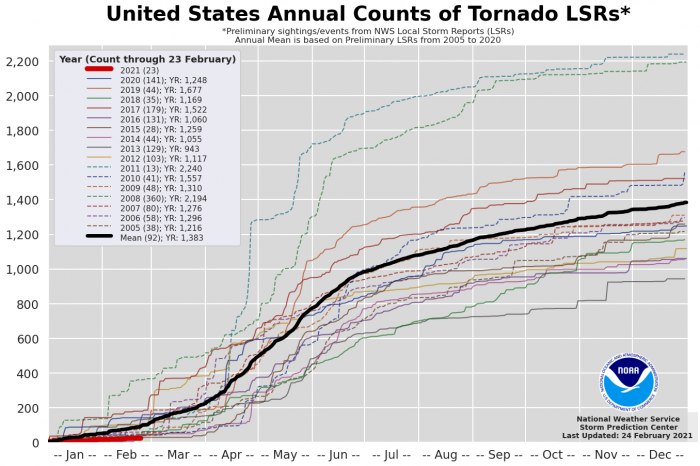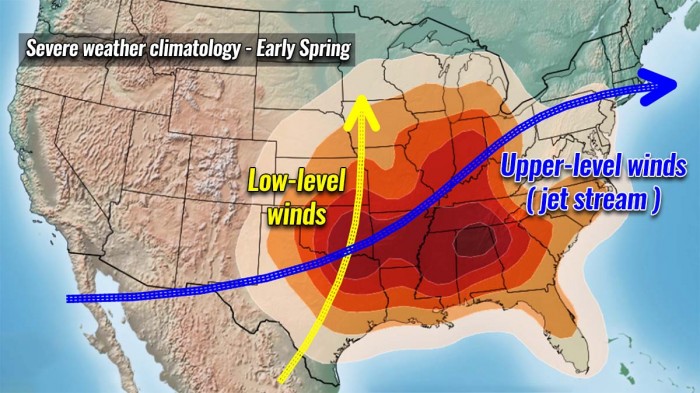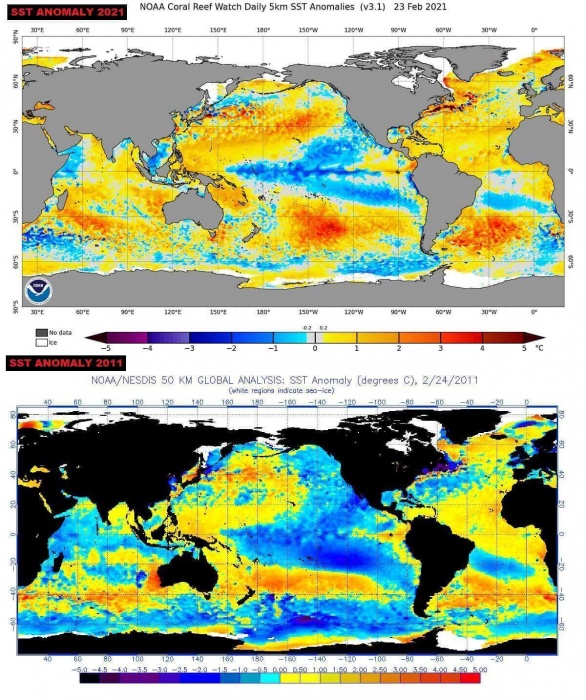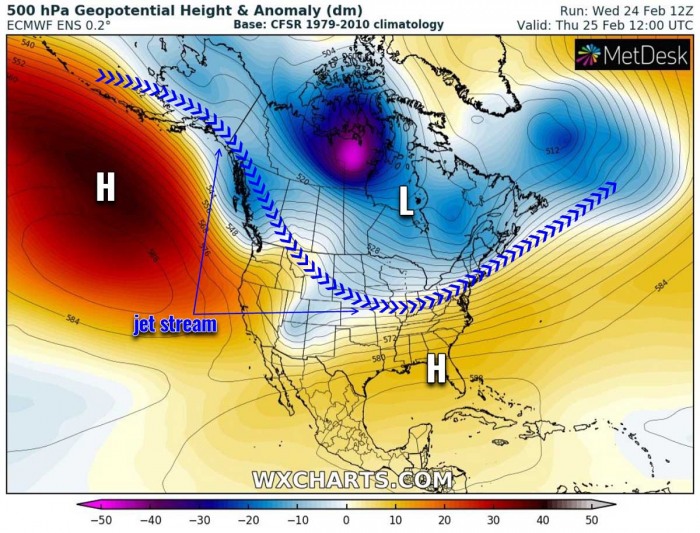We are just a few days away from the official start of the meteorological spring, as well as a new tornado season in the United States. This year, an ongoing La Nina could lead to increased severe weather events and above-average tornado activity. Cold delays the season, but then it ramps up. Here is what we know so far.
*** IMPORTANT UPDATE ***
Tornado season 2021 is here: above-average activity likely this spring
Although we might be seeing a slow start this year, severe weather activity has kicked-off earlier than usual over the last couple of years. It seems the trend will follow them again this year with an above-average tornado season this spring.
The above-normal Gulf of Mexico waters play an important role as they provide fuel for the storms. The other factor is the jet stream, the upper-level winds, which are stronger than normal in some of the years.
A combination of both, the enhanced jet stream and warm/moist lowest levels of the atmosphere, brings the ingredients together that lead to organized severe storms, including tornadoes. Those normally increase during the spring months, from March through June.
As we can see from the chart above, as of February 23rd, there were 23 tornadoes reported across the United States so far. Including two destructive tornadoes with 4 fatalities (one in Alabama on Jan 25th and three in North Carolina on Feb 15th). This is indeed a quite slow start, about one-third of the typical ~65 tornado reports during January and February.
Thanks to the below-average central Pacific water temperature, a moderate La Nina could trigger significant tornado activity this spring. This is a natural cycle and is one of the main drivers of weather dynamics around the world, most importantly during the winter and early spring seasons.
The opposite effect is El Niño, characterized by the warming of these same waters and leading to different effects on weather patterns across the US and worldwide.
This weather pattern continues as we’re ending the harsh meteorological winter across part of North America. After the Polar Vortex collapse back in early January, the winter weather has significantly ramped up across the United States. And lead to a historic and deadly cold outbreak across the southern Plains through mid-February.
The general weather models are lately trending that such a pattern is likely to persist into March and April this spring. And a typical La Nina often brings a more robust tornado season and a higher frequency of severe events.
Both Tornado Alley and the Dixie Alley tend to get more dangerous severe weather when cooler Pacific waters are present. La Nina also brings about 4-6 weeks earlier tornado season starts and tends to be more active than normal.
Obviously, no seasons are alike and their activity can vary significantly. Tornado season 2021 will be lead by La Nina. The animation below reveals the evolution of these cooler than normal equatorial Pacific waters over the last couple of months. The difference is very well seen.
Annually, severe storm activity ramps up around the Gulf Coast first, then gradually spreading northward through March into April. Thanks to the enhanced and more northward position of the upper-level winds this year, storms could be stronger. Those can produce heavy rain and flash flooding, very large hail, destructive winds, and tornadoes.
Dixie Alley, for instance, receives more tornadoes, including strong ones, when La Nina is on. But can we see a sign of what’s coming up this spring? You might have heard some talks that we might be in for a very dangerous season and rival the 2011 tornado season? That year had a huge anomaly and the Pacific waters were much cooler than normal.
What are the odds that the historic cold outbreak, putting a large part of the country into a deep freeze last week, will play a role in the future patterns through early tornado season activity this year? Let’s first see what are the main ingredients for these dangerous weather events.
Then, we will dig into the latest trends and what we could conclude regarding the upcoming US tornado season 2021 so far.
EXTREME INSTABILITY, WIND SHEAR, AND JET STREAM
The general thunderstorms form when surface heating results in upward rising (convection) warm and moist air mass, typically along with some kind of the existing frontal boundary (cold front, dry line, outflow boundaries, etc.). With air rising, it condenses and creates precipitation. Finally, when combined with thunder and lightning, a thunderstorm is born.
Although these general thunderstorms are quite common throughout the year, sometimes the environment has ingredients present that result in more volatile storms and therefore also potentially dangerous weather events. That’s when severe storms form. Supercell thunderstorms are the most severe and the most dangerous storms, leading to flooding, destructive hail, winds, and tornadoes.
The main ingredients determining the type or intensity of the potential severe weather (storms) are usually the available energy, known as instability, and the winds. Both low-level and upper-level winds, and the wind shear.
Generally speaking and very simplified: the higher the instability and winds/shear, the more robust and organized/dangerous storms can develop.
(Extreme) instability
When we talk about the instability, we have in mind the potential energy the environment has available to fuel the storms. The more energy is in place, the more vigorous convection and unstable the environment can result. Sometimes even explosive development of the storms.
This is where the Gulf of Mexico water temperatures come into play as it has a direct influence on the tornado season activity across the South and Southeast parts of the US. The region known as the Dixie Alley.
The source of a very moist air mass comes from the deep south tropical region, as far as from the Caribbean Sea waters. In the final month of this winter, the water temperatures over the Caribbean region are around 1-1.5 degrees Celsius above the average.
This is quite a concerning signal for the upcoming tornado season as this high moisture is then gradually spread into the United States mainland during the spring months, starting in March and increasing through May and June. So the energy could get very high once the significant warming starts in the coming weeks this year.
Let’s remember: The higher the moisture and temperature, the higher energy accumulates. And this directly translates into more robust convection and severity of the storms.
Wind shear and jet stream
Another ingredient needed for storms to get going and organize is the wind. Actually throughout the whole atmosphere, from the low-levels to the upper-levels. The latter is known as the jet stream.
The jet stream brings very strong winds and enhances the wind shear – a change of wind speed and its direction with height. Wind shear is, besides instability, the important key in severe thunderstorm environments. Changing winds with height lead to a rotating updraft of the storms, helping them to sustain and live longer.
Normally, with the transition from winter to the spring season, these upper-level winds – the jet stream, begin their typical retreat towards the north. This year, the La Nina will keep the jet stream stronger than usual. It also amplifies the winds closer to the ground, meaning that the moist and very warm air mass from the Gulf of Mexico can push farther north.
The chart above indicates the typical early Spring climatological activity of the severe weather across the US. We can see the highest frequency across the South and Southeast parts of the country. The blue arrow represents the general position of the upper-level winds while the yellow arrow are the low-level winds. Both will be amplified this spring.
According to the studies of the tornado environments across the Tornado Alley, these winds tend to be stronger in early spring, in March, and April when the Pacific waters are cooler than normal. And that’s why these patterns have such an important role in predictions of what to expect during a tornado season.
La Nina typically boosts the severe thunderstorms environment as well as leading to potentially more robust and dangerous tornado outbreaks.
COOLER PACIFIC WATERS, JUST LIKE IN 2011
As mentioned earlier, seasons do vary from year to year, so we also need to compare the timeframes prior to spring (the winter months) to get the first idea. For example, if we compare 2021 and last year, there was no significant cold outbreak in the late winter while we had a very significant, long-lasting cold blast lately.
But there is one interesting, and potentially fundamental fact; the tropical Pacific waters are similarly cool compared to the infamous year 2011. Remember, April 2011 was extremely active with deadly tornado outbreaks which spawned more than 700 tornadoes in a single month.
The so-called “2011 Super Outbreak” (April 25–28th, 2011) was the largest, the costliest, the most expensive meteorological disaster, and one of the deadliest tornado outbreaks in American history on record. Leaving catastrophic destruction across the Southern, Midwestern, and Northeastern United States. In just a four-day span, violent supercell storms spawned three EF-5 tornadoes in addition to 12 EF-4 and 21 EF-3 tornadoes.
April 27, 2011, was the day we all want it has never happened. It remains entitled as the deadliest day for tornadoes since the “Tri-State” outbreak almost 100 years ago, March 18th, 1925. Leaving 316 people dead on this single day.
So, similar to spring 2011, the cooler Pacific waters are about to remain through at least April or even May this year. Persisting right through the heart of the typical US tornado season. And both years can relate to each other even more.
Both 2011 and 2021 have had a rather slow start (remember the chart we attached earlier). And we see what April exactly 10 years ago did then – by the end of the month, there were already more than 1200 tornadoes reported in the United States. 2011 literally exploded in April.
TORNADO SEASON SLOW START, BUT COULD KICK-OFF SOON
We can blame the frigid and destructive cold outbreak for the bad weather lately, but it might be a lifesaver at one stage so far. Thanks to the strong dynamic weather patterns across North America since mid-late January, convective activity and frontal systems with dangerous severe storms were lacking.
The consecutive widespread Arctic outbreaks have pushed the frontal systems and storm tracks much farther south, so most of their activity was limited to the Gulf, the Gulf Coast, and Florida.
Statistics don’t lie, the tornado season has so far produced ‘only’ one-third of the usual tornado reports across the United States. The states of Alabama, Georgia, Florida, and North Carolina have seen a few, unfortunately also damaging.
But we could soon be in for a significant ramp-up once the conditions improve and the environment warms up. If you are a storm chaser, your time is coming soon.
Normally, the interaction of the cold air masses coming from the north with the much warmer air mass farther south, lead to frontal systems and convective weather. This is most defined during late winter into spring transition, as both pressure and temperature gradients between the north and south are the most pronounced.
As we know from the past observations, the effect of the La Nina going from winter into spring hints at a strong blocking high-pressure system in the North Pacific that leads to lower pressure to its east, over Canada, and over the United States. This is exactly what has happened this year, like going by the book.
There is a high-pressure system (H) over the North Pacific and another one over the southern US, while a large low-pressure system (L) is over Canada and the northern tier of the United States. In between, a powerful jet stream is blasting high-speed winds. A textbook example of the La Nina pattern over the North American continent.
And it seems it will take a few more weeks that a significant activity will begin across the south where the severe weather and tornado season normally starts in March. Thanks to the still favorable pattern for some cold air intrusions south into portions of the US. So we could expect somehow below-average activity to continue into March.
Then, trends are turning that season gets more active as April approaches. As soon as the cold will leave, warming will make its role for sure. We can just remember how remarkable warming came over Texas this week. Compared to the deep freeze last week, temperatures jumped for more than 80 degrees F (45 °C) in just a one-week timeframe!
Dallas plummet to -2F (-18.9 °C) last week and jumped to an impressive 80F (26.7 °C) on Tuesday this week. The incredible comparison chart above is provided by Scott Duncan.
VERY ACTIVE TORNADO SEASON LIKELY
And you can imagine, warming has never been an issue. Then think about the ongoing stronger jet stream with persistent La Nina? It does hint at what’s coming up ahead for this tornado season. It is obviously not that simple, of course. But we could see a very active April this year. Might just continue the streak of the Aprils in recent years.
As the pattern also continues and extends into May, tornado season will keep storm chasers very busy this year.
The latest weather model trends also suggest that the main activity this upcoming tornado season might be off the traditional Tornado Alley – the area covering the southern and central United States into the Midwest with an annual high frequency of severe weather hazards and tornadoes.
Tornado season this year might well be shifted into the central Gulf Coast and into low-mid Mississippi Valley. But indeed, that does not mean the traditional Tornado Alley will not see tornadoes. But it might keep the numbers below average.
With the gradual retreat of the upper-level jet stream above the strong temperature contrast below, the states around the Mississippi river up towards the Tennessee valleys and east to Alabama might be in higher danger through late March and April.
Basically, the area being known as the Dixie Alley, often experiencing deadly tornado outbreaks in the past.
Going deeper into the month of May and June, the typical northward shift of the jet stream will occur. But it will remain strong, so the tornado season will probably continue as above-average.
The potential area with the highest number of tornadoes this year is surely not the most favorable area for storm chasers, but more importantly, it is also a very unfriendly area for the local residents when tornadoes occur.
The low-mid Mississippi Valley is full of trees and high humidity, so tornadoes are even more dangerous while having a lack of good visibility e.g. on the flat open fields of the Great Plains (Tornado Alley).
Similar activity was also seen in the spring 2011 season, as the Mississippi and Tennessee Valleys were also badly hit with destructive tornadoes.
WORSENING SOUTHWEST US DROUGHT COULD INFLUENCE THE STORMS
One of the negative factors to be considered influencing the upcoming tornado season could be the ongoing, severe to extreme drought conditions across the western portions of the United States. With a typical La Nina pattern extending into this spring, it will likely worsen the drought.
According to the latest US Drought Monitor data, exceptional drought conditions are observed across parts of Colorado, Utah, Nevada, Arizona, New Mexico, and far West Texas. Further below-average precipitation in the upcoming months will also increase fire threats, as well as increase possible early intense heat waves.
So, the ongoing and worsening drought could be one of the reasons why the eastward shift off of the traditional Tornado Alley activity might follow this spring. Drier air is a limiting factor for widespread and volatile thunderstorm environments.
As we learned earlier, the high moisture is, besides the high upper-level winds, one of the key factors for potential instability and violent storms to occur.
***The images used in this article were provided by NOAA, Tropical Tidbits, and Wxcharts.








